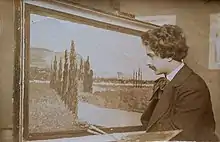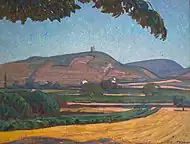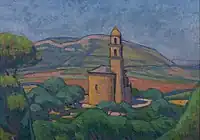Robert Deborne | |
|---|---|
 Robert Deborne | |
| Born | 22 July 1870 Ardèche, France |
| Died | 27 July 1944 (aged 74) Ardèche, France |
| Nationality | French |
| Known for | Painting, drawing, and landscapes |
| Movement | Post-Impressionist, Fauvism |
| Elected | Salon d'Automne |
Robert Deborne (22 July 1870 – 27 July 1944), was a French Post-Impressionist painter born in Viviers, in 1870. He focused on painting landscapes of Viviers and the surrounding countryside as well as Nebbio, in Corsica. Deborne is best remembered for his Post-Impressionist works, and his contribution to Fauvism.
Personal life
Deborne was born in 1870 in Viviers, France to Robert François Abel Deborne and Clémence Barruol. His father was a wealthy landowner and this provided him with the financial security to concentrate on painting. Little is known about Deborne's childhood. He attended school in Lyon before marrying and moving to Meudon, Paris in 1900. In 1903 he exhibited in The Paris Salon[1] and, in 1905, the Salon d'Automne.[2] Deborne and his wife had two children before they divorced in 1923. He died in his studio in Ardèche on July 27, 1944, at the age of 74.
Work
Deborne mostly painted scenes of Viviers, his home town on the Rhône, and its surrounding areas. His works are very much centered on the places that he loved. He returned to the same landscapes again and again to depict the variations in time, weather and season.
Salon d'Automne
Deborne exhibited at the Salon d'Automne between 1905 and 1927 and was accepted as a member of the Salon d'Automne 1923.[3] Deborne was inspired by the work of Cézanne,[4] and he exhibited with Cézanne on at least two occasions: in the 1905 Salon d'Automne. 3e Exposition,[5] and the 1906 Salon d'Automne. 4e Exposition.[6] Deborne exhibited at the Salon d'Automne in 1905,[7] the year when the press coined the then rather disparaging term of Fauves (French for ‘wild beasts’) to describe artists using strong, separate, unnatural colours in a representational manner, moving away from the realism of impressionism. The phrase stuck and the new movement of Fauvism was recognised, of which Deborne was certainly a part and influenced by.
Friendship with Signac
In 1928, the President of the Salon des Indépendants asked Deborne to find housing in Bourg-Saint-Andéol, and then in Viviers for Paul Signac. The two painters would meet and paint together on the banks of the Rhône. Signac and Deborne went on to exhibit together on several occasions at the Salon du Sud-Est.
Gallery
 Hilltop Tower by Robert Deborne
Hilltop Tower by Robert Deborne Deborne Painting of Church
Deborne Painting of Church Country Lane
Country Lane
References
- ↑ "Catalogue illustré du salon de 1903". Paris : Librairie d'Art, Ludovic Baschet. Retrieved 30 March 2021.
- ↑ "Salon d' Automne, 1905". Archive of American Art. Retrieved 30 March 2021.
- ↑ Benezit Dictionary of Artists. Oxford University Press. 2010. ISBN 9780199773787.
- ↑ "1904 | Société Cézanne". la Société Paul Cézanne. Retrieved 5 April 2021.
- ↑ "Autumn Fair. 3rd Exhibition". Database of Modern Exhibitions. Retrieved 5 April 2021.
- ↑ "Autumn Fair. 4th Exhibition". Database of Modern Exhibitions. Retrieved 5 April 2021.
- ↑ "Salon d' Automne, 1905". Retrieved 21 May 2021.
External links
 Media related to Robert Deborne at Wikimedia Commons
Media related to Robert Deborne at Wikimedia Commons

